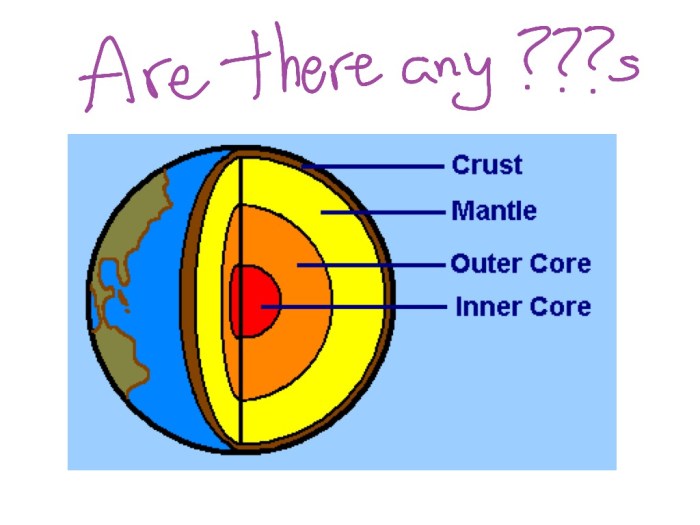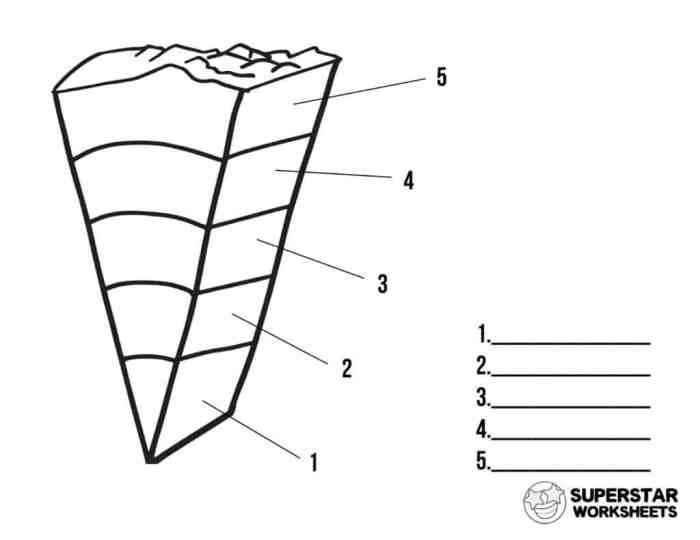Color by number layers of the earth is a pedagogical tool that utilizes colors to represent the Earth’s distinct layers, providing a simplified and engaging method to comprehend the planet’s intricate structure.
This approach not only enhances understanding but also facilitates the visualization of complex geological concepts, making it a valuable resource for educators and researchers alike.
Color by Number: Illustrating the Layers of the Earth: Color By Number Layers Of The Earth

Color by number is a technique that assigns different colors to represent distinct layers or components of a system. In the context of the Earth’s layers, color by number serves as a visual aid that helps simplify and illustrate the complex structure of our planet.
Using color by number offers several benefits: it enhances visual understanding, simplifies complex concepts, and facilitates the memorization of different layers and their characteristics.
Layers of the Earth
The Earth’s structure consists of several concentric layers, each with unique composition and properties.
- Core:The Earth’s innermost layer, composed primarily of iron and nickel, with temperatures exceeding 5,000 degrees Celsius.
- Mantle:The thickest layer, located between the core and the crust, composed mainly of silicate rocks.
- Crust:The outermost layer, composed of solid rock and minerals, and is relatively thin compared to the other layers.
- Atmosphere:The gaseous envelope surrounding the Earth, composed primarily of nitrogen, oxygen, and other trace gases.
Color Coding System
The color coding system for the Earth’s layers typically follows a logical and intuitive scheme:
- Core:Red or orange, representing its high temperature and molten state.
- Mantle:Green or blue, representing its solid but deformable nature.
- Crust:Brown or yellow, representing its solid and rocky composition.
- Atmosphere:Blue or white, representing its gaseous state and the presence of water vapor and clouds.
Applications of Color by Number
Color by number has various applications in education, research, and data visualization:
- Education:Color by number is a valuable tool for teaching students about the Earth’s layers and their characteristics, making complex concepts more accessible.
- Research:Color by number can assist in visualizing and analyzing geological data, helping researchers understand geological processes and phenomena.
- Data Visualization:Color by number can be used to create maps and diagrams that illustrate the distribution and variation of different geological features, such as rock types or tectonic plates.
Limitations and Considerations, Color by number layers of the earth
While color by number is a useful tool, it has certain limitations and considerations:
- Oversimplification:Color by number may oversimplify the complex nature of the Earth’s layers, which can have variations and gradations in composition.
- Misinterpretation:The color coding system may not always accurately represent the physical properties of the layers, leading to potential misinterpretation.
To mitigate these limitations, it is important to use color by number in conjunction with other representations, such as cross-sections or diagrams, and to provide additional information and context.
Questions and Answers
What are the benefits of using color by number to illustrate the Earth’s layers?
Color by number simplifies complex geological concepts, making them more accessible and visually appealing. It enhances understanding and facilitates the visualization of the Earth’s structure.
What is the rationale behind the color choices used in color by number representations of the Earth’s layers?
The color coding system is designed to convey information about each layer’s composition and characteristics. For instance, the core is often depicted in red or orange to represent its high temperature, while the mantle is commonly shown in green or blue to symbolize its silicate-rich composition.
What are some limitations associated with using color by number to represent the Earth’s layers?
Color by number representations can potentially oversimplify complex geological concepts and may not accurately reflect the gradual transitions between layers. Additionally, the choice of colors can be subjective and may vary depending on the source.
